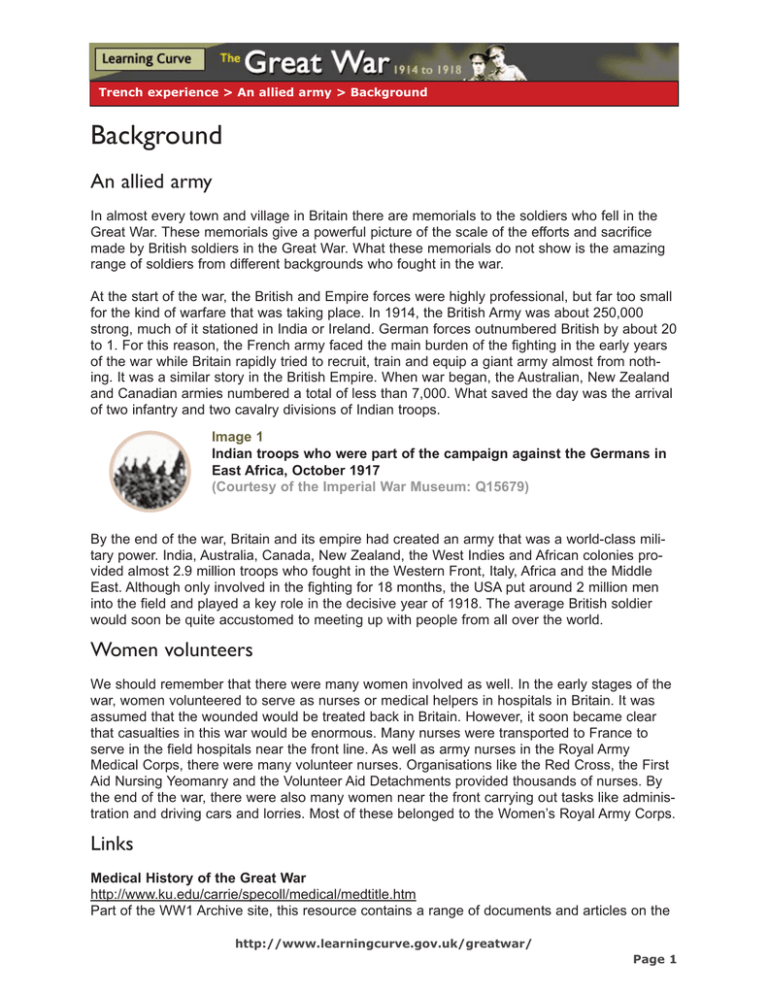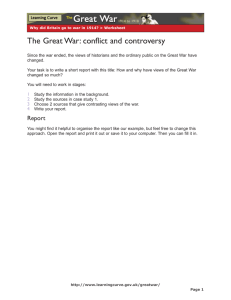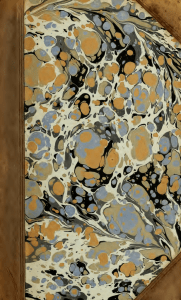Background An allied army
advertisement

Trench experience > An allied army > Background Background An allied army In almost every town and village in Britain there are memorials to the soldiers who fell in the Great War. These memorials give a powerful picture of the scale of the efforts and sacrifice made by British soldiers in the Great War. What these memorials do not show is the amazing range of soldiers from different backgrounds who fought in the war. At the start of the war, the British and Empire forces were highly professional, but far too small for the kind of warfare that was taking place. In 1914, the British Army was about 250,000 strong, much of it stationed in India or Ireland. German forces outnumbered British by about 20 to 1. For this reason, the French army faced the main burden of the fighting in the early years of the war while Britain rapidly tried to recruit, train and equip a giant army almost from nothing. It was a similar story in the British Empire. When war began, the Australian, New Zealand and Canadian armies numbered a total of less than 7,000. What saved the day was the arrival of two infantry and two cavalry divisions of Indian troops. Image 1 Indian troops who were part of the campaign against the Germans in East Africa, October 1917 (Courtesy of the Imperial War Museum: Q15679) By the end of the war, Britain and its empire had created an army that was a world-class military power. India, Australia, Canada, New Zealand, the West Indies and African colonies provided almost 2.9 million troops who fought in the Western Front, Italy, Africa and the Middle East. Although only involved in the fighting for 18 months, the USA put around 2 million men into the field and played a key role in the decisive year of 1918. The average British soldier would soon be quite accustomed to meeting up with people from all over the world. Women volunteers We should remember that there were many women involved as well. In the early stages of the war, women volunteered to serve as nurses or medical helpers in hospitals in Britain. It was assumed that the wounded would be treated back in Britain. However, it soon became clear that casualties in this war would be enormous. Many nurses were transported to France to serve in the field hospitals near the front line. As well as army nurses in the Royal Army Medical Corps, there were many volunteer nurses. Organisations like the Red Cross, the First Aid Nursing Yeomanry and the Volunteer Aid Detachments provided thousands of nurses. By the end of the war, there were also many women near the front carrying out tasks like administration and driving cars and lorries. Most of these belonged to the Women’s Royal Army Corps. Links Medical History of the Great War http://www.ku.edu/carrie/specoll/medical/medtitle.htm Part of the WW1 Archive site, this resource contains a range of documents and articles on the http://www.learningcurve.gov.uk/greatwar/ Page 1 Trench experience > An allied army > Background efforts of civilian and military medical staff in the war. Kent Voluntary Aid Detachments http://www.juroch.demon.co.uk/kentvad.htm A university researcher created this site on the VAD units of Kent. Irish Regiments in WW1 http://www.dungarvanmuseum.org/exhibit/web/Display/article/31/1/ A site connected to the Dungarvan Museum, this has a useful outline of Irish recruitment in the Great War. Australian War Memorial http://www.awm.gov.au/atwar/ww1.htm This has a useful outline of the role of Australian forces. New Zealand and the Great War http://www.greatwar.org.nz/contents.htm This website has articles on the ANZAC experience in the Great War. India and the Western Front http://www.bbc.co.uk/history/war/wwone/india_wwone_01.shtml Here is a detailed and helpful analysis of the experiences of Indian troops and the factors that motivated them. Canada and the First World War http://www.collectionscanada.ca/05/0518_e.html This website from the National Library and Archives of Canada looks at Canada's contribution to the war and the campaigns fought by Canadians. Imperial War Museum Collections http://www.iwmcollections.org.uk/commonwealth/essay.asp This provides a brief outline of the contribution of Commonwealth forces to conflicts of the 20th century. Memorial Gates Trust http://www.mgtrust.org/index.htm This charity commemorates the contribution of Indian, African and Caribbean troops to the Great War and the Second World War. http://www.learningcurve.gov.uk/greatwar/ Page 2



